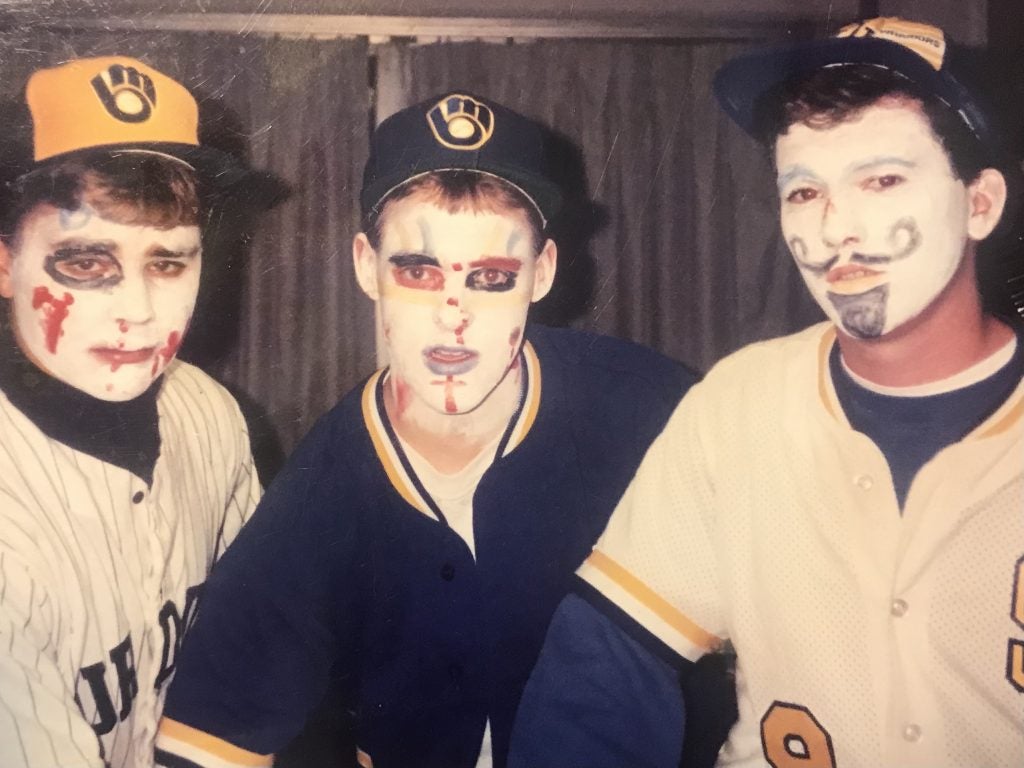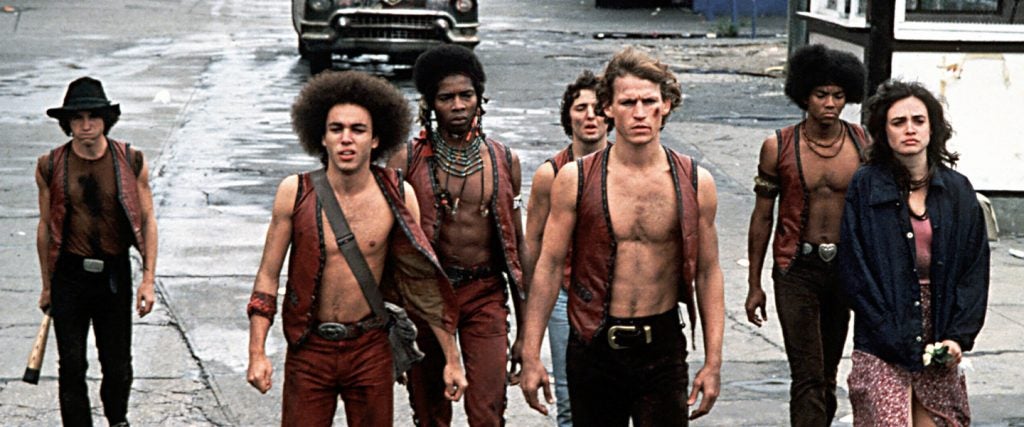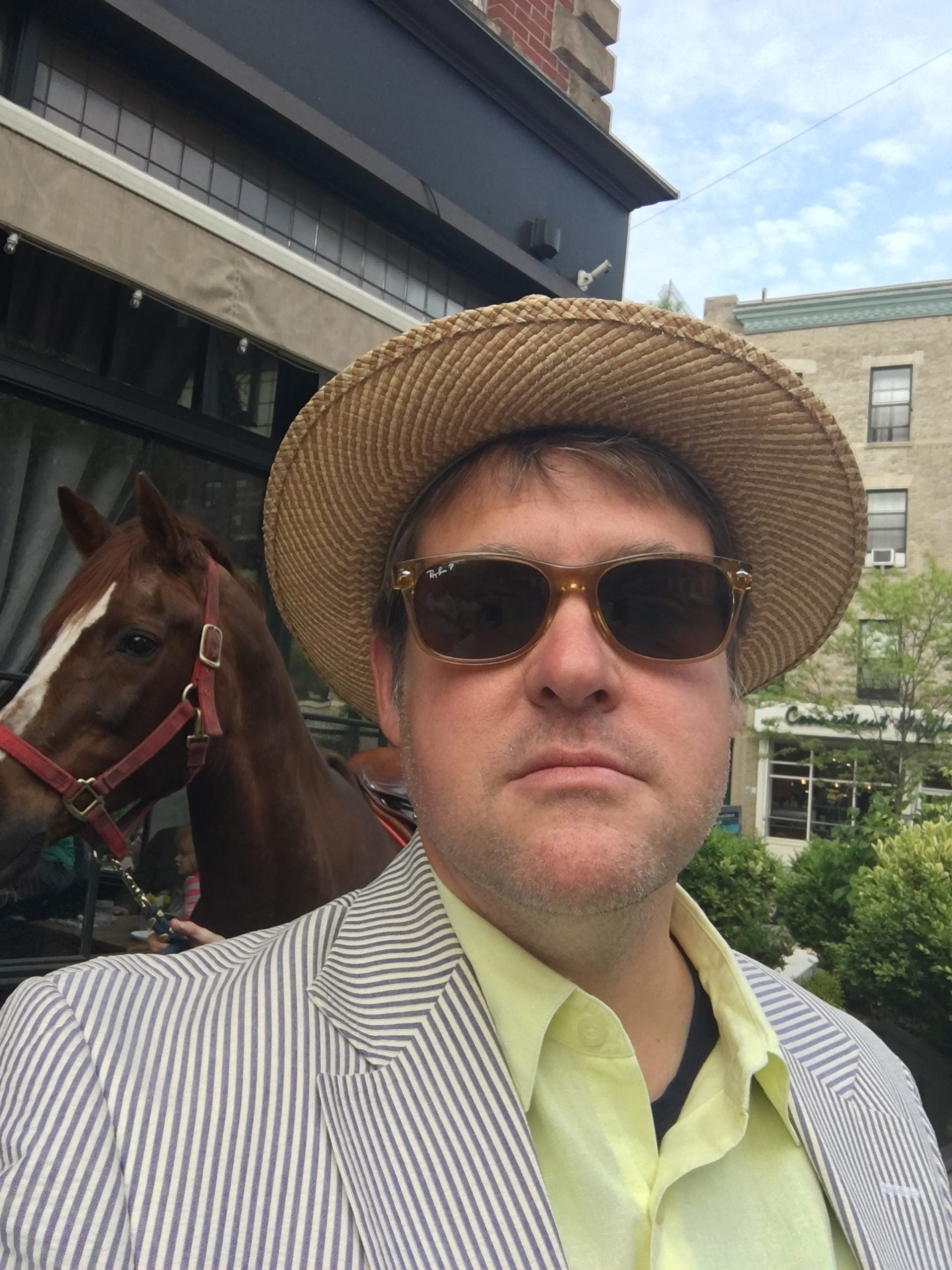It was my freshman year of college in the waning days of the 1980s, and Halloween had arrived. Being 18-year-old dipshits who put little effort into anything outside of scoring Old Milwaukee, my friends and I had no costume game plan and it was party go-time. One of my dorm-mates went back to his room and grabbed three high school baseball jerseys (which he brought to college for reasons that remain unknown). Being Marquette students, we quickly found Milwaukee Brewers caps to match the color scheme, slapped on some cheap makeup, pulled out wiffle-ball bats and ta-da:

Can you dig it?
If you instantly recognized our transformation into the uber-cool Baseball Furies then you already dig The Warriors cult. Based on the Ancient Greek classic Anabasis by Xenophon, Sol Yurick’s brutal 1965 novel provided the template for Walter Hill’s infamous 1979 film version, which upon release, would become so notorious for its alleged on-screen violence and actual off-screen violence, that The Warriors would vanish from screens despite being the most popular movie in America at the time.
For the uninitiated, the story is simple: The Coney Island-based Warriors travel to the Bronx for a conclave called together by Cyrus, leader of the Gramercy Riffs, to more or less call a truce among gangs, form a union of their 100,000 members, run New York City and split the financial spoils. But during his speech, Cyrus is shot and killed by Luther, the half-psycho/half-coward leader of the Rogues. The murder is pinned on the Warriors, who in the dystopian “Drop Dead” NYC-era darkness, have to traverse 27 miles of abandoned streets and sinister subway rides back to Coney Island, all while dodging and battling insanely-attired gangs such as the slick all-African-American Boppers, the wiley all-girl Lizzies and the anarchic skinhead-ed Turnbull ACs.
The Warriors violent reputation is fascinating because the movie just isn’t. Sure, it was filmed on the streets of NYC during the late 1970s low point, when crime was rampant, cocaine was everywhere, the Bronx was burning, the Son of Sam had just been nabbed and it seemed like the end of civilized city times. On-screen, however, there is little murder, pillaging, shoplifting or jaywalking to be found. Less blood is shed than in an average episode of CSI. What makes The Warriors a pop-art masterpiece is that it isn’t some terrifying amalgamation of Taxi Driver, Death Wish and Colors. In fact, it took on a long life of its own because it isn’t a depraved glorification of gratuitous violence. The Warriors is a pastiche of comic books, choreography, Moog Music, graffiti art, extravagant outfits and breakneck pacing that renders large gaps in logic (like, why not just steal a car?) and stilted one-dimensional dialogue moot.
Tragically, though, this strange, pulsating, idiosyncratic movie was linked to three killings and sporadic gang fights and vandalism. As such, it didn’t take long for moral panic to set in and for the movie to represent serious national problems of lawlessness, brutality, poverty and urban decay. As Andrew Sarris of the Village Voice wrote at the time, “the movie looks as if Fritz Lang had directed The Wiz,” while positing that because the actual streets of New York were “dying, block by block, from fear, loathing, fire and desertion” perhaps preventing some viewers from seeing The Warriors made sense, but certainly not the on-screen “pussycats” and the movie itself.
Can You Dig It: The Phenomenon of The Warriors by London native Sean Egan lays out the entire wild Cyclone ride of the last 40 years, from screenplay inception, to hiring actual gangbangers as extras, to firing the leading man mid-shoot, to the editorial page outrage, to the film’s beloved convention cosplay and cult-classic status of today. Egan is the writer and editor of more than 30 books including works on David Bowie, Manchester United, The Clash, Planet of the Apes and James Kirkwood, the forgotten bisexual Tony/Pulitzer-Award winner who co-authored A Chorus Line. His latest work, however, is a must for anyone who yearns for Swan, Cleon, Fox, Ajax, Cochise, Rembrandt, Mercy and Co. to…
I recently caught up with Egan to discuss why the novel the movie is based on is so bad, the genesis of the film’s signature lines and how Ronald Reagan was an unexpected Warriors stan.
Let’s start with your relationship to The Warriors: When were you first aware of it?
It came out when I was in my teens, but in England, it was an 18 Certificate, which meant I wasn’t old enough to see it. It’s my understanding England was much stricter about the age rules than America. It was sort of like when the Sex Pistols’ Never Mind the Bollocks came out — you couldn’t hear it. All you knew about was the scandal, so The Warriors carried a mystique and an aura of dread. I did have the poster magazine for the film, which explained the plot and featured stills and production notes. That was the extent of my knowledge.
Do you recall when you finally saw it?
I didn’t see it until 20 years later, when the DVD came out. I was shocked at how tame the movie was compared to its reputation. It’s deliberately tame, really. It’s a comic book, not intended to be realistic at all. There was an absolute disconnect between the reputation that preceded The Warriors and its actual content.
I never read Sol Yurick’s novel, but you make it clear there was much more savagery in it — murder, gang rape, etc. — so it sounds like the original source material was a lot closer to what the movie was made out to be?
Yes, had they filmed Yurick’s version, the sensational media coverage might have been somewhat justified for glamorizing nihilistic violence. But as a film, The Warriors isn’t like say Breaking Bad, where the creators don’t give a toss if the audience empathizes with the protagonist, it’s almost the opposite. The Warriors are generally decent fellows, they don’t rob, mug, beat or even harass people. They’re basically just good-looking guys from the same neighborhood who hang out together in leather vests. They’re a “gang” that doesn’t participate in actual gangbanging outside of a bit of graffiti.
The Warriors is a case where the movie is much better. Yurick’s book isn’t particularly well-written; it’s all shorthand and feels like a screenplay treatment. There are a couple of good chapters toward the end, but what struck producer Larry Gordon was the basic story idea. He loved the idea of these guys facing all manner of obstacles trying to get back to Coney Island, not the specific content of the novel. I think Gordon bought the rights without ever having read Yurick’s book.
The movie’s promotional material was darker as well — the crazy poster, the threatening trailer, the whole “Armies of the Night” vibe.
In the 1970s, there was a certain menace in the air. It felt like civilization was decaying. You had all of the 1960s degeneracy without any of the hippie optimism. In England, we were seeing more and more brutal violence from football hooligans, and in New York, there was street-gang warfare all across the city. In that atmosphere, The Warriors is promoted with a tagline about how 20,000 cops are far outnumbered by 100,000 gang members. It’s a terrifying notion, but it’s also an exciting one. We’re all thrilled by violence — so long as it’s movie violence. Were the promotional materials for The Warriors irresponsible? It presents a darkness the movie doesn’t possess, so maybe, but probably not if your job is to get people in the theater.
You have a line in the book that makes a lot of sense in explaining why some of the real-world violence popped off — that even though The Warriors is generally bloodless, “everything in it seems to endorse confrontation.” Can you expand on that idea a bit?
In the film, characters are constantly squaring up to each other, even Swan (Michael Beck) and Mercy (Deborah Van Valkenburgh) in their love scene. And the Warriors barely say a civil word to each other; it’s typically, “Hey man, if you wanna challenge me, make your move.” In an earlier draft of David Shaber’s script, there is actually a tender moment when one of the guys tells Rembrandt (Marcelino Sanchez) not to let go of his spray-paint cans because it’s his ticket out of Coney Island. Walter Hill told me he cut it out because it was too much of an aspirational bourgeois sentiment and not true to these working-class guys — the same guys who went to see The Warriors opening weekend, propelling it to number one at the box office. Gang members were going to see The Warriors because it was about their world. The movie didn’t cause fights to break out, but when you have rival gangs in the same theater, it’s almost inevitable something will go down. The filmmakers weren’t thinking several steps down the line, but a film about confrontation unfortunately led to confrontations.
It was a really hard time for the actors, incredibly tough what they went through. It was the roller-coaster of the euphoria of starring in a hit movie, to suddenly being linked to deaths in the newspapers, to having the movie pulled from theaters. They were all young, just starting out for the most part, so it had to be a difficult period for them.
Did the movie get yanked from theaters? It’s murky as to what exactly happened.
Walter Hill swears blind that just the advertising was pulled. Larry Gordon swears blind that the movie was removed from theaters. I represented both their points of view, but in the ancient world of the 1970s, I’m not sure there’s a definitive way to nail down the precise facts. What’s important is whatever happened, it sullied the movie’s name, and Paramount didn’t want the negative publicity. The Warriors wasn’t banned, it played in some theaters and the studio offered to pay for extra security, but the public outcry — protesters at screenings, condemnation from columnists and politicians alike — kept it from becoming the huge hit it might have been.
The Warriors are a multicultural gang. Was that accurate?
Not at all. Cleon (Dorsey Wright) grew up in the Bronx and told me there were gangs everywhere but none with the makeup of the Warriors. Maybe you’d get a mix of Blacks and Puerto Ricans, but even that wasn’t the norm. Walter Hill didn’t want a multi-ethnic cast, but the studio was afraid if it was all-Black and Latino, no white people would go see it. The nonstop buzzword today is diversity, so Hill was accidentally ahead of his time. At one point in the script, Hill had an all-gay gang, The Dingos, which would have been truly daring. Although The Warriors is still a product of its time in other ways — they didn’t cast an American Indian to play Cochise, and Mercy would definitely be much more of a central ballsy character today.
The movie has two fantastic lines I want to ask you about —
Let me guess, the same two everyone recites whenever The Warriors is mentioned? They’re both all in the performances. By the time the movie was filmed, “Can you dig it?” was an embarrassing 1960s anachronism. It was Shaber showing his age there. Cyrus (Roger Hill) delivers it so powerfully that he turns a pig’s ear into a silk purse. Somehow, the dated phrase makes perfect sense.
Walter Hill said “Warriors, come out to play” is something Luther (David Patrick Kelly) came up with on his own. Again, it’s all in the delivery. He grabbed three beer bottles off the ground, and started clanking them together. It’s an eerie sound in itself, especially since you aren’t sure where it’s coming from when you first hear it. Then Luther starts repeating the line, building it to a demented crescendo. The two lines brilliantly bookend The Warriors.
It feels to me like the film has amassed a bigger following in the last two decades — probably due in part to its frequent hip-hop references and the 2005 Rockstar video game — but when did it first start to become a cult classic?
In 2017, Beck told Leonie Cooper of New Musical Express, “In the early to mid-1980s, I had a friend who had been on vacation in Paris. When he returned, he said, ‘You won’t believe this: There was a midnight screening of The Warriors, and it was like The Rocky Horror Picture Show. All the people were dressed up as the characters.’ That was the first inkling. I went, ‘Wow, something else is happening with this movie.’”
Is part of the enduring love for The Warriors a nostalgia for a New York City that no longer exists?
I never visited 1970s New York City, but I’m surprised how often people tell me it was reminiscent of that decaying time because the movie is too cartoonish to be a realistic depiction of the era. But Mayra Sanchez, sister of Rembrandt, says it reminds her of their New York City childhood. So it’s a factor, but the vast majority of people who love The Warriors never experienced 1970s New York. I don’t think it plays that big of a role in the movie’s resonance.
What do you chalk it up to then? It’s a strange movie to have survived and thrived for as long as it has.
From the opening shot of the neon Wonder Wheel, The Warriors feels unique. It’s a hodgepodge. The Warriors isn’t a musical, but it puts you in mind of West Side Story with the choreographed fight scenes. The battle scenes with the Baseball Furies are beautiful in a Jets and Sharks way, just nobody breaks out in song. As individuals, some of the characters are thin, but as a collective, the Warriors are easy to root for, a cool group of chiseled half-naked boys next door who happen to dress up in outlandish costumes, framed for a murder they didn’t commit. Hill told the first nonjudgmental story about gangs and told it stylishly. Barry De Vorzon’s ominous instrumental synthesizer score was new, an innovation that added to the wild atmosphere. Even the wet streetscapes are amazing. It was done intentionally to ensure rainstorm continuity and the street lamp reflections look gorgeous on the tarmac.
There was one thing from the book that left me completely dumbstruck. Before we part, can you please tell the Ronald Reagan fanboy story?
Beck got a call from someone in the White House saying the new president had screened The Warriors at Camp David and wanted to send his congratulations. A few weeks later, Beck was stunned to receive a handwritten note from Reagan. Maybe, as a former actor, his love of great cinema isn’t predicated on, or compromised by, his ideological bent, but it’s surprising that the law-and-order Reagan was a fan of a dystopian New York City crime fantasy. It feels like he would’ve been in on the vocal condemnation. But that apparently wasn’t the case at all.

